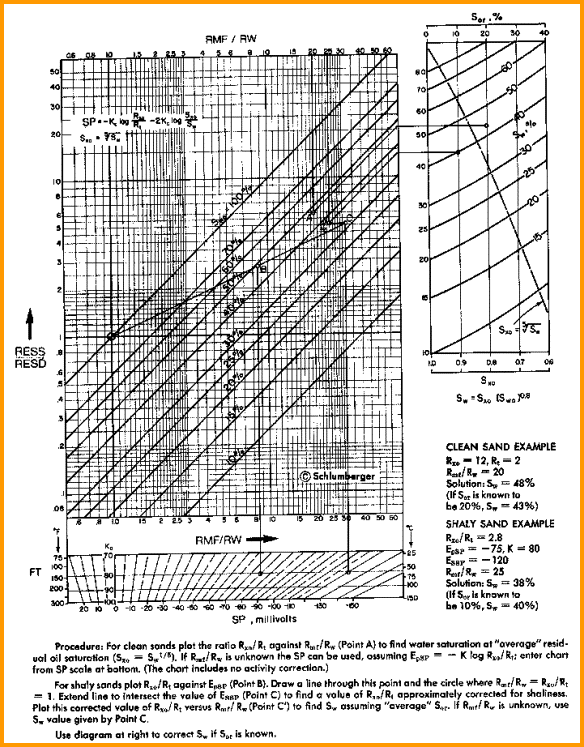|
 Water Saturation from Ratio Method
Water Saturation from Ratio Method
When no porosity data is available, saturation can be obtained
by comparing the shallow and deep resistivity logs. This formula
is not shale corrected.
1: SWrt = SXO * ((RXO / RESD) / (RMF@FT / RW@FT)) ^ (1 / N)
Where:
N = saturation exponent (fractional)
RESD = resistivity reading on deep log (ohm-m)
RXO = resistivity reading on shallow log (ohm-m)
RMF@FT = mud filtrate resistivity (ohm-m)
RW@FT = formation water resistivity at same temperature as RMF
(ohm-m)
SWrt = water saturation from ratio method (fractional)
SXO = estimated water saturation in invaded zone (fractional)
A
common assumption is that Sxo = Sw^(1/5). Substituting this into
equation 1 and assuming N = 2, we get:
2: SWrt = ((RXO / RESD) / (RMF@FT / RW@FT)) ^ (5/8)
 COMMENTS:
COMMENTS:
See
below for a graphical solution to this formula. The
method is a last resort to be used when no porosity log is available.
If
there is a nearby water zone AND it has the same porosity as the pay
zone, the Rmf/Rw ratio can be estimated from the Rxo/Rt ratio in the
water zone, and used in equation 1 or 2, thus exact knowledge of Rw
is not required.

Graphical solution for Ratio method (with shale
correction from SP)
 RECOMMENDED
PARAMETERS:
RECOMMENDED
PARAMETERS:
N = 2.0
for water zone SXO = 1.00
for hydrocarbon zone with high porosity SXO = 0.60
for hydrocarbon zone with medium porosity SXO = 0.70
for hydrocarbon zone with low porosity SXO = 0.80
for heavy oil and tar sands, SXO = SW = 0.10 to 0.30
NUMERICAL
EXAMPLE:
1. For Sand C:
RESD = 1.0 ohm-m
RESS = 2.0 ohm-m
RMF = 0.75 @ 25 degrees C
RMF@FT = 0.54 @ 43 degrees C
RW@FT = 0.036 @ 43 degrees C
N = 2.00
Swr = (2.0 / 1.0) / (0.54 / 0.036) ^ (1 / 2) = 0.36
|

